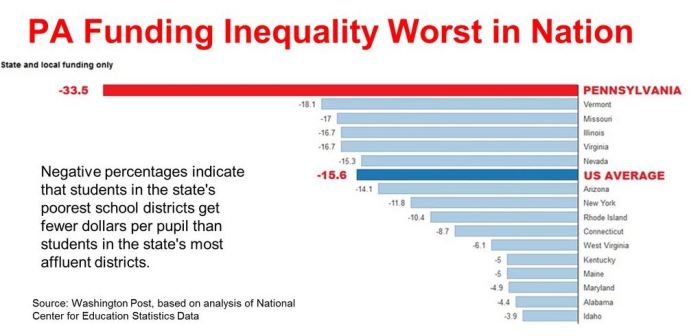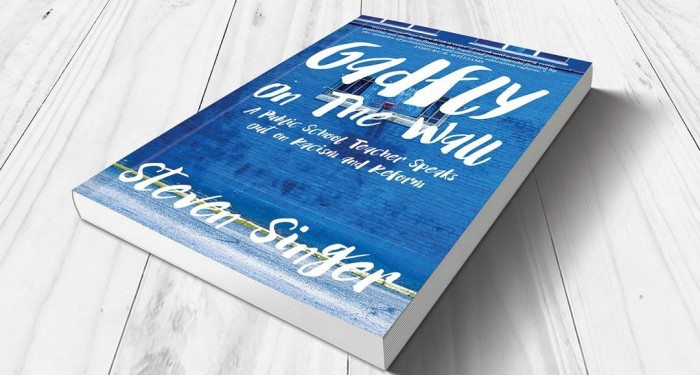What if instead they took to the streets with signs and placards, bullhorns and chanted slogans.
Maybe:
“Hey! HEY! Ho! HO! This Unfair Funding Has to Go!”
Or:
Or:
“What do we want!? FAIR FUNDING! When do we want it? YESTERDAY!”
The problem is that from Pittsburgh to Philadelphia and all places in between, the Keystone state has the most unequal school funding system in the country. And no one in Harrisburg seems able and/or willing to do a damn thing about it.
Nor is anyone going to do much again this year.
Gov. Tom Wolf didn’t mention it once last week during the Democrat’s first budget speech to the legislature after being re-elected.
Don’t get me wrong. He’s not exactly ignoring the issue. His newly proposed budget asks for a $200 million increase in education funding.
But that’s far from what’s needed to heal the billions of dollars schools lost during the massive budget cuts of Tom Corbett, the former Republican governor, nor does it address the underlying inequity of how we fund these schools in the first place.
Every year Democrats complain about the problem, suggest repairing it, and then are denied everything but an incremental increase by the Republican-controlled legislature.
Every year, that is, until this one.
This is the first time Democrats have seemingly given up on solving the problem and just proposed the incremental increase that they suspect Republicans will approve.
It’s a pitiful situation to accept as status quo.
One could argue that it’s the electorate’s fault. After all, if they keep voting for Republicans that make it clear they don’t support equity in education, that must represent the will of the people.
Except it doesn’t. Fair funding is popular among voters everywhere in the Commonwealth. And it’s one of the reasons they elected and re-elected Wolf. However, when it comes to state government, legislative districts are so gerrymandered, the will of the people gets ignored.
In November, Democrats got 381,000 more Pennsylvania votes than Republicans to represent them in the state House. But Republicans still kept the majority.
So what can you do when your voice is smothered by red tape?
You can turn to the Democratic governor who is the only thing stopping the opposition from gutting schools even further. You can ask him to push lawmakers on both sides of the aisle to get off their collective asses and do their jobs.
But Wolf does not seem ready to spend his political capital in this way.
According to an Associated Press article by Marc Levy:
“For his part, Wolf’s office says he remains open to a discussion with the Legislature on making school funding fairer. However, someone else may have to carry the torch.”
Just who could this “someone else” be?
As usual, it may have to be the Commonwealth’s teachers.
As in every state, when governments and communities can’t or won’t do right by their children, educators step up.
We buy classroom supplies, we feed the hungry, we dry the tears, and when all else fails we put our jobs on the line and strike until school boards, legislatures and governors do the right thing.
Some have suggested that’s what’s needed here.
There have been at least nine large-scale teachers strikes across various states in the last 12 months. This includes actions in Arizona, Georgia, Kentucky, North Carolina, Oklahoma, Virginia, West Virginia, and – most recently – Los Angeles, California, and Denver, Colorado.
The Denver strike ended Thursday morning with an agreement between the Denver Classroom Teachers Association and Denver Public Schools. After three days on the picket line, teachers may be returning to their classrooms having achieved their goals.
In today’s climate of dark money and political gridlock, collective action seems the only way to get anything done.
Perhaps we need an army of the state’s 123,000 educators to walk out of their classes in unison demanding fair funding for our most vulnerable students.
Such a move would be unprecedented. To my knowledge, teachers strikes in the Commonwealth have always involved educators and staff at one of the hundreds of districts, not a unified action of teachers throughout the state. A movement on this scale would require cooperation and buy in from the Pennsylvania State Education Association (PSEA), National Education Association (NEA) and American Federation of Teachers (AFT). And union bosses are rarely motivated to endorse such measures without being forced to it by grassroots pressure from members.
Moreover, it would put teachers unions in a dangerous position. Each district contract has a no strike/no lockout clause guaranteeing that membership won’t walkout during the life of a contract. Where we’re seeing these major nationwide strikes either the contract has expired like in Denver and Los Angeles or they’re so-called “Right-to-Work” states without these explicit worker protections.
It’s doubtful the state could actually fire and replace the more than 100,000 teachers in its employ, but the worst case scenario for a state-wide strike in Pennsylvania would be the invalidation of all existing contracts, the loss of arbitration, grievances, collective bargaining and even putting retirement at risk.
That’s a lot to ask of educators – though creative organizers could find ways to avoid or mitigate the risk – for instance with a sick out or mass demonstrations on weekends or holidays.
I – for one – am sick of watching my middle school students overstuffed into classrooms with crumbling infrastructure and meager resources while a few miles down the road the rich kids have small classes and schools that look like palaces. I’ll bet there are a lot of teachers and parents who feel the same way.
Perhaps it’s time for us to take to the streets.
Perhaps it’s long past time.
When I say the state is the most inequitable in the country, that’s not hyperbole.
It’s according to several studies done over multiple years by groups like the Associated Press and the U.S. Department of Education.
More than any other, the Keystone State gives a boost to rich kids and a boot to poor ones.
Why?
You have to understand where the money comes from to educate kids in America.
Public schools have basically three revenue streams – the federal government, the state and local neighborhoods.
The federal government pays about 10% of the cost across the board. The problem in Pennsylvania is that the state isn’t meeting its obligation thereby forcing local neighborhoods to shoulder most of the cost.
Pennsylvania state government pays a ridiculously low percentage of the bill – 38%. That’s the 46th lowest in the country. The national average is 51%.
In rich neighborhoods, this is no problem. In middle class communities, it’s not much of one. But in poor communities, there isn’t enough money to make up the difference. Their kids have no choice but to do without.
So kids from rich communities get everything. Kids from middle class communities get most of what they need. And kids from poor communities get whatever scraps are left at the bottom of the barrel.
And it’s an intolerable situation!
According to an Associated Press analysis of 2016-17 state data on school district spending, middle class districts spend as much as $673 more per student than poor districts. Rich districts spend about $4,300 more per student.

According to the U.S. Department of Education, poor schools in the Commonwealth spend 33 percent less on their students than rich ones. That’s a significantly larger difference than the next-closest state, Vermont, where the spending difference between rich and poor schools is only 18 percent. Three other states — Illinois, Missouri and Virginia — have gaps of 17 percent.

We can’t keep kicking minorities and the destitute to the curb. We can’t keep giving the rich and middle class every opportunity to succeed while depriving the poor of that same chance.
Wolf, the Democrats and a few Republicans have tried several times to fix the problem.
First, they attempted large increases in education funding to catch up to where funding would be if the Corbett cuts hadn’t happened coupled with the rising costs caused by inflation.
In 2015, the governor proposed a $400 million increase but funded it with a tax increase on the rich that almost all Republicans refused.
Then he tried to bring the state share of education funding up to 50% by using a more equitable tax plan. He proposed cutting property taxes in poorer districts and replacing them with higher state taxes elsewhere. However, Republicans saw it as an opportunity to completely eliminate property taxes and cut school funding even further. It ended in a stalemate and another incremental education increase.
If the legislature wouldn’t approve the necessary spending increases to heal the cuts it made under Corbett, Wolf at least wanted lawmakers to approve dividing the money up more fairly among the state’s 500 school districts.
A funding formula had been approved four years ago to reflect changes in school district attendance and wealth that had been ignored for a quarter century. This would result in more support for poorer schools and less for wealthier ones.
And there’s the sticking point. Lawmakers wouldn’t approve a plan that would provide less funding to 70% of the state’s districts – but neither would they increase school spending to make up the difference.
You’d think that such legislative gridlock might make voters lose hope. However, there is a mass movement of people at the grassroots level demanding change for our children.
The lawsuit – now in its fourth year – is scheduled for trial before the state Supreme Court in 2020. So at best, relief is still a ways in the future. Many are hoping justices will order the legislature to dramatically increase its investment in public schools. But the outcome is certainly not a sure thing.
Could striking teachers in red and blue states be showing us in Pennsylvania the solution?
Might it be time to raise our teacher voices in the purple states, too?
And is there a path to equity through collective action that doesn’t hang teachers out to dry?
Still can’t get enough Gadfly? I’ve written a book, “Gadfly on the Wall: A Public School Teacher Speaks Out on Racism and Reform,” now available from Garn Press. Ten percent of the proceeds go to the Badass Teachers Association. Check it out!


No comments:
Post a Comment
Note: Only a member of this blog may post a comment.